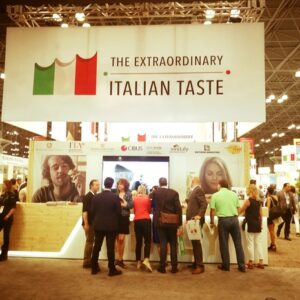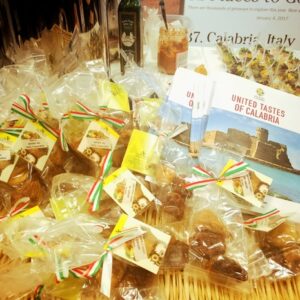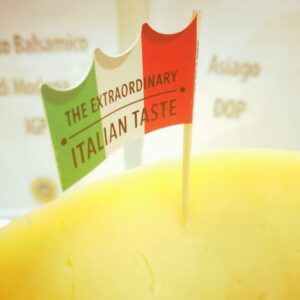A popular Chinese proverb says “eating is one of the four purposes of life. The other three, nobody has ever had a clue about.” The whole world is discovering the importance of eating well, enhancing food culture by highlighting raw materials and production procedures. And Italy is leading the way.
It is no easy task to summarize the 63rd Summer Fancy Food Show at the Javits Convention Center in New York City from June 23 through 27, 2017. One might say it’s an almost impossible mission. Figures can help, though. Organized by the Specialty Food Association, the fair welcomed over 180,000 products and 2,400 exhibitors from 50 different countries, among which Italy was queen, boasting more than 300 companies and 284 booths within the Italian pavilion and dozens more scattered throughout the different areas of the show. Located right in the heart of the exhibition venue, the Italian area underwent a massive restyling: the 2017 annual has called for new layouts and visitor and distributor-friendlier spaces with an overall design-related revamp. As usual, Italy’s participation was organized and coordinated by Universal Marketing.

The Specialty Food Association and Universal Marketing welcomed the Italian companies together with the Italian Trade Agency which took part in the event in collaboration with the Italian Ministry of Economic Development, the Italian Ministry of Agriculture, Federalimentare, CIBUS, Tuttofood and Vinitaly.
Trade Commissioner Maurizio Forte told us “export data confirms the excellent job carried out by the Italian companies. From our side, we provide the institutional support through a special promotion plan in the U.S. and we’ve struck twelve deals so far with large-scale retail traders, thanks to which 450 new suppliers have been included.”
The Italian Trade Agency has provided exhibitors with information and assistance services and invited key American players in the sector to visit the Italian pavilion, and to taste the products on display. They also set up the spaces for show-cooking sessions, meetings, a coffee area and the wine bar — managed by Vinitaly International.
Among the numerous innovation ideas 2017 Summer Fancy Food has brought about was an initiative in collaboration with the Ministry of Agricultural and Forestry Policies to use only IGP and DOP products (Protected Geographical Indication and Protected Designation of Origin) for the show-cooking sessions in the meeting area.
“One more way to showcase our territorial excellence,” Mr. Forte said.
Luigi Polizzi from the Ministry of Agriculture and Consul general of Italy in New York Francesco Genuardi also welcomed the Italian companies at Summer Fancy Food.
Calabria Makes the News
Events such as the Fancy Food Show allow the best Made in Italy products to showcase their qualities. But even outside of the show, the spotlight stays on Italy when it comes to nutrition: a National Geographic article from 2013 links the Mediterranean diet to longevity, based on research on Calabrian centenaries conducted by the University of Calabria in collaboration with the University of South California in Los Angeles. The New York Times also included Calabria among the places to visit in 2017. With those two important distinctions in its pocket, the region presented itself to the public at the Fancy Food Show. It was the only region of Italy with its own booth.

“Rich in vegetal proteins yet poor in animal proteins, our traditional diet has gained attention for its tasty ingredients and for the attempt by both universities to save it,” Giuseppe Passarino, Professor Emeritus of Genetics at the Biology Department in Reggio Calabria, told us from inside the Calabrian booth. In this regard, nutritionist Dr. Martina Bonofiglio added that a new food pyramid called “PAST” is currently under construction, “whose base — if you want a healthy and long life — is taken by vegetal products and fruit, which are typical of the Calabria region.”
Italian Awards
The Italian pavilion also hosted the first edition of the Italian Food Awards, a creation of Food Magazine and Universal Marketing and supported by the Specialty Food Association. Thirteen prizes distributed after a jury of mostly Americans rewarded excellent products for their drive towards innovation.

For both winners and other participants, the Summer Fancy Food Show was a great opportunity to highlight the quality of their products. In a context where the consumer becomes a prosumer, buyers want to know what’s behind the products, and in the age of storytelling, being able to tell each company’s tale is a marketing necessity. Territorial roots and familial traditions tell American consumers stories of authenticity and excellence.
Between the aisles at the Summer Fancy Food we have heard many of those stories, jumping from the starters to the main course and the desserts as in a feast. The many Italian companies shaped the classical backbone of an “Italian-style menu,” balancing between the traditions of the past and the challenges of the future in an ever-changing market.
Antipasti – A Taste of the Sea
In a typical Italian-style appetizer, colors are vital. La Vucciria, a Sicily-based company, recently entered the American market offering their high quality products through a sophisticated kind of packaging by combining design and food. “We are proud to be here,” said General Manager Antonio Di Dio. “With our products, such as pistachio cream with Etna Valley pistachios and canned tuna, we are trying to bring the excellence of Italian products beyond the borders of our peninsula.”

These days, the term “appetizer” may refer to many different things, in Italy just like in the U.S. Renna Antipasti knows it well. Established in Fasano (Brindisi) in 1967 by a family of fishermen, the company can be found in the U.S. since 1993 with its seafood appetizers, eggplants, octopus and anchovies. “We have entered the market by following Italians’ migration flow. It allowed us to understand where and when to invest,” explained Francesco Renna, who has taken on the leadership of the company in its third generation and has got familiar with the prerogatives of the American market. “Consumption of our products here is not as different as in Italy. What does differ, though, is the kind of market in which it takes place.”
Primi – Pasta and All Kind of Sauces
Any way you slice it, the first course is always the main course. The variety of products Italy can offer allows the consumer to set off for very different journeys. Classic among classics is pasta. At this Summer Fancy Food, between the show-cookings and the various booths, spaghetti and tagliatelle, rigatoni and fusilli were everywhere. A constant line stayed in front of the La Pasta di Camerino booth as visitors waited to try chef’s Rosanna Di Michele dishes.

Founded in Camerino (Macerata) in 2002, La Pasta di Camerino has been on the U.S. market for two years. “By strictly complying with the recipe of Marche Region tradition, the dough consists of eight eggs for one kilo of maize meal, and gets kneaded three times for thirty minutes a time,” Federico Maccari explained. Yet tradition synthesizes with innovation. “In the American contemporary market, you have to show what is behind the product: to do it, we have decided to rely on Shazam. By taking a picture of the code on our products with your smartphone, you can discover, via an app, where the raw materials came from, how they are handled and how they can be used.”
There is no pasta without a sauce, and good pasta demands one of high quality. Just like Italianavera’s — on the American market since 2015 — enhances the pasta. “The American market feeds on a large number of different sauces, but they are very standardized,” Diana Attianese explained. “With products such as our ‘Mammamia’, we try to evoke a genuine taste which brings you back to the authentic homemade Italian sauce.”
If not pasta, the first course can be rice. Not yet fully understood by Americans, rice has a huge potential. “We are an agricultural holding, producing rice and placing ourselves onto the “consumer” market as a ‘risotteria,’” Gianmaria Melotti of Riso Melotti told us. According to Gianmaria, “we need to stop fooling Americans around with poor-quality ingredients: they are curious and can appreciate the story of the product that will end up onto their table.”

Cooking pasta or rice takes time, though. And as Fancy Food 2017 has been the year of innovation, a ingenious idea has been brought about: an Asian noodle-type cup to guarantee the quality of the handmade pasta. “To give Americans the chance to buy a quality canned product, which is also al dente and certified, is a huge innovation we Europeans might consider unthinkable,” Alvise di Canossa of Pasta di Canossa told us. Yet it started out in Ferrara one century ago and has recently made it to the American market. In its simplicity, this pasta is an absolute novelty: just add a few spoons of water to the pre-cooked pasta and then some dried penne and you will have a real Italian “primo” in a few seconds.
Secondi – How about a Piatto Freddo?
As we are deep in the summer, the ability to prepare a tasty second course without spending hours in the kitchen would be ideal. So why not go for a good cold dish (“piatto freddo,” as we call it in Italy)? For this purpose,, ingredients abound in Italy. And so do producers at Fancy Food 2017, such as Mò Bufala, an Andria-based dairy farm established about one year ago, but boasts 300,000 Euros in revenue in 2016, and massive growth forecasts for 2017. “We target one million,” the company, whose assets are crystal clear, told us. They say they can manufacture a buffalo mozzarella of exceptionally high quality by covering portions of a niche market and avoiding consortiums. “American factories have taken advantage of our failure to promote our local products. But we believe we can reverse the trend.”
Good mozzarella makes a delicious match with any kind of cold cut: from ham to bresaola, from salami to bacon, to some luscious dry-cured ham, whose exportation to the U.S. is regulated by recently changed rules that make organizing in consortiums the best option for many producers. “We have been exporting our product since when they opened up the market. While coordinating with the consortium in the last two decades, the most difficult thing has been to fight back attempts from the so-called ‘Italian-sounding,’ and to protect our geographical indications through educational activity,” Mattia Zambroni of San Nicola di Parma told us.
Pizza – The Queen of the Italian Table
If you’d rather have a one course meal, to settle the argument and get everyone to agree for good, you just need to name it — the queen of the Italian table: pizza. At the Summer Fancy Food Show there were all sorts of pizza, from the wood oven to the pre-packaged ones, all ready to eat. And though it’s certainly true that Americans appropriated this dish and almost forgot its Italian origins, a good dough and flour can make the difference, and it’s notion is getting an increasingly leading role. “We cannot tell the Americans how to dress their pizza, but we can propose to the market a kind of quality dough with which they can prepare it better,” Massimiliano Bertuzzi, the Sales Manager of Molino Pasini, said to us.
Seasoning – A Pinch of Salt and Some Drops of Oil
If there’s no seasoning is involved you might as well forget about your first and second courses. Good oil and good salt do make the difference. Berio knows it well: this year they celebrate their 150th anniversary of leadership in the olive oil manufacturing sector by returning to “year zero.” “Filippo Berio was a pioneer and an innovator,” Marco de Ceglie, Chief Executive Officer told us. “Our aim now is to reach out to new consumers: we were recently included on Amazon. And on June 29, a food truck set off to tour the United States to teach people 150 ways to cook with Berio olive oil.”
The market for olive oil also has its own niches. Just think about Oleificio Gabro, of Sibari, Calabria, recognized for three generations of oil-makers, and the first company to receive the “organic” certification in 1988. “We monitor each stage of the production process.” Giovanni Brogna said. “We are very strong abroad where the organic culture has driven our market forward,” he added.
There’s to authentic Italian seasoning than oil, though. Some may say salt is salt, but picking the right one must not be overlooked. Especially rock salt, which many Americans are unfamiliar with. “Our basins produce salt all year,” Giulio Piazzolla, of SAI Sali Alimentari e Industriali, told us. “But the extraction doesn’t take take place until the fifth year. This way the crystals are very stiff, white and high-quality.”
Dessert – Italy in a Christmas Cake
Panettone may sound a bit out of season in the summer. But after enjoying an appetizer, a first course, and then a rich cold dish as a second, we reach the dessert area and a new wide range of options opens up. The quality of Nicola Fiasconaro’s products at Fancy Food might make any dessert naysayer to change their mind. “We are bakers at heart. We cover a portion of high-quality gourmet markets and keep avoiding mass markets,” Fiasconaro told us, emphasizing that “at the beginning the idea of a panettone coming from Sicily and not from Northern Italy was hard to accept. The consumer needs to be made familiar, not forced.”

Fancy Food always offers plenty of alternatives, and this year was no exception. For instance, Forno d’Asolo-Donatella’s baked goods, which got to the American market in 2016, where available there. “You need a lot of patience and commitment,” Alberico Marotta, the Regional Sales Manager, told us. “Yet the market is there, and the demand is starting to pick up. Among the Americans’ most beloved baked products, ricotta-and-pear cake and limoncello babbà. Not to forget, of course, a timeless classic — tiramisu.”
Coffee and “coffee-killer” – Rounding Off
And on top of it all, should we not have a coffee? On the famous drink, the ongoing debate is still wide open. Funny to think how espresso is taking off in the U.S. as Italy is ready to welcome Starbucks and its big cups of ‘Italian sounding’ mixes. In this context, placing one’s own product on the market is no easy business. Caffè Trobetta believes that “local communities should be addressed through an educational approach, and attempts should be made to raise awareness among young globe-trotting generations towards indigenous coffee.”
Dinner over? Definitely not. In the classical Italian-style menu, you cannot leave the table before sipping an ammazzacaffè — a small glass of liqueur usually consumed after coffee. In Italy it is a must. But in the U.S.? “Not yet, even if some new trends have been emerging, especially over the last three years,” explained Alessio Pane, Vice President of Distilleria F.lli Caffo for the U.S., which introduced the Amaro del Capo to America. “There is an increasing number of bartenders which use our product to prepare high-quality cocktails,” he told us.
In the end, once a product has been explained and its standards guaranteed, the American market can spread its arms to potentially anything. Insofar as its quality is worth it, ovviamente.
Watch our video coverage of the Summer Fancy Food Show.
Allegra De Lorenzo contributed reporting.
* errata corrige: In a first draft of the article, we had approached the name of Agostino Iacobucci with Pasta di Canossa. Instead, the name of the producer of Pasta di Canossa we talked with was Alvise di Canossa.












